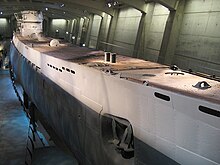U-571
| Movie | |
|---|---|
| German title | U-571 - Mission in the Atlantic |
| Original title | U-571 |
| Country of production |
USA , France |
| original language | English |
| Publishing year | 2000 |
| length | 111 minutes |
| Age rating | FSK 16 |
| Rod | |
| Director | Jonathan Mostow |
| script | Jonathan Mostow, Sam Montgomery , David Ayer |
| production |
Dino De Laurentiis , Martha De Laurentiis |
| music | Richard Marvin |
| camera | Oliver Wood |
| cut | Wayne Wahrman |
| occupation | |
| |
U-571 is an American war film from 2000 about the (fictional) capture of the secret encryption machine Enigma by the US Navy on board a German submarine during World War II . The film received the 2001 Oscar for best sound editing .
action
In the spring of 1942, the German submarine U-571 attacked an Allied cargo ship in the Atlantic before being discovered by an Allied warship and fought with depth charges. The submarine is damaged in the process, and the chief engineer and other technical staff are also killed. The boat is unable to maneuver and sends encrypted messages for help. The Americans listen to the signal; Although they do not understand it because of the encryption, they suspect based on the bearing and the last reported position that U-571 is unable to maneuver, especially since, according to information from the Resistance, a supply submarine left the war port of Lorient to rescue it.
The US Navy then dispatched its S-33 , disguised as a German supply submarine , to board U-571 and steal the Enigma encryption machine on board. Major Coonan and another member of the Office of Naval Intelligence are said to be assisted by First Officer Tyler, the chief of the boat, and a few sailors. During the attempt to board the Americans, dressed in Kriegsmarine uniforms, the Germans recognized them, but despite some losses they were able to take over U-571 and secure the Enigma. The German prisoners are brought to S-33. In the meantime, however, the real German supply submarine has arrived: It torpedoed S-33 and sunk it.
The US sailors can dive with U-571 and sink the supply submarine with torpedoes. On the surface of the water they search for survivors and take in the Afro-American cook's mate Carson and the German commander of U-571, who does not reveal himself as such. With actually too few crews, they are trying to reach England. Although not familiar with the technology, the technically experienced US machinist Clemens succeeds in repairing the ship's diesel. When they encounter a German destroyer , the latter initially misjudges the situation. With a targeted shot with the on-board cannon, they succeed in putting the destroyer's radio room out of action and thus preventing its radio traffic to Germany. With a daring diving maneuver under the destroyer the escape succeeds. The German captain is caught in an act of sabotage and kills a soldier. The destroyer throws depth charges. U-571 discharges cargo, oil and the dead through the torpedo tubes in order to pretend that the submarine has been destroyed. The ruse seems to be successful, but then the tied German commander marshals the destroyer's position by knocking on the submarine wall. He is slain. U-571 had to surface badly damaged, but was able to sink the destroyer with its last torpedo.
The survivors climb out of the sinking submarine with the captured Enigma machine into an inflatable boat and are later rescued by a Catalina flying boat.
Reviews
The film received generally good reviews in the United States. Rotten Tomatoes rated 78 out of 115 reviews as positive (68%) and summarized them to the effect that excellent film technology and an interesting plot accompanied by a talented cast and crew make the film an exciting thriller. The film was also a commercial success.
In Germany and Great Britain, the reviews were clearly more negative. In the often drawn comparison to Das Boot, U-571 performed significantly worse almost across the board. It was often criticized that attempts had been made to copy the style-defining classic of the genre - with the difference that the heroes were Americans to satisfy the patriotic feelings of the main domestic market. The historical representation was often described as completely unrealistic, even if the film has its strengths in terms of dramaturgy and tone.
The Rhein-Zeitung wrote:
“Original camera perspectives and an authentic background noise ensure that the [film] appears realistic and casts a spell over the audience. […] However, 'U-571' does not come close to Wolfgang Petersen's classic 'Das Boot'. The story of a daring Allied crew who was forced to perform a dangerous mission in a German submarine in the war year 1942 is probably too heroic. "
The online film magazine Filmstarts judges:
“Only those who do not expect a psychological depth, simply want to enjoy two hours of solid pyrotechnics and switch their brains to standby, will have a touch of joy with 'U-571'. Unfortunately, the film's orientation towards the American target group has to be noted very precisely - and the Americans just want to think as little as possible. Anyway, the better choice is to watch Wolfgang Petersen's classic 'Das Boot' for the 20th time instead of wasting your time on 'U-571'. "
The Guardian criticized the second-rate and all-American cast with Matthew McConaughey, Harvey Keitel, Jon Bon Jovi and others and described the film as a desecration of the memory of the Royal Navy members, who in the realm of history are the first Enigma machine from a German U Boat.
Awards
- 2001: Oscar for the best sound editing .
- 2001: Oscar nomination for best sound
Historical background

The plot of the film is largely fictional: The real U 571 was sunk in 1944 west of Ireland by a Sunderland flying boat . It had nothing to do with the shooting of allied castaways, this was done by U 247 and U 852 . The only type of support submarine of the Kriegsmarine was U-Boot-Klasse XIV and had no torpedo tubes. USS S-33 served in the Pacific throughout the war. However, the Allies' efforts to capture the secret German encryption machines were real:
- On May 9, 1941, the British destroyer HMS Bulldog U 110 attacked and captured an intact Enigma M3 machine including code books .
- On October 30, 1942 , a prize squad from the destroyer HMS Petard boarded the German submarine U 559 and captured important secret key documents such as short signal booklet and weather short key , with the help of which the code breakers in Bletchley Park , England , also managed to overcome the Enigma-M4 .
- In June 1944, the USS Pillsbury captured U 505 with its Enigma machine and encryption documents.
In the end credits of the film, the historical actors in the battle for Enigma are honored. David Balme, who, as an officer in the Royal Navy, led the boarding party that raised the U 110 at the time, was involved in the production of the film. He described U-571 as a great film and admitted that it would not have been financially viable without the Americanization of the plot.
Web links
- U-571 in the Internet Movie Database (English)
Individual evidence
- ↑ Entry on U-571 on Rotten Tomatoes
- ↑ 'U-571' Runs Noisy, Runs Strong The Los Angeles Times, May 2, 2000
- ^ Susann Huster controversial submarine action thriller from Hollywood , Rhein-Zeitung from January 15, 2010
- ^ Criticism from Filmstarts.de . Retrieved April 19, 2010 .
- ↑ Alex von Tunzelmann U-571: You give historical films a bad name , The Guardian of February 26, 2009
- ^ Hugh Sebag-Montefiore: ENIGMA - The battle for the code . Cassell Military Paperbacks, London 2004, pp. 149ff. ISBN 0-304-36662-5
- ↑ Stephen Harper: The Battle for Enigma - The Hunt for U-559 . Mittler, Hamburg 2001, pp. 50ff and 66ff ISBN 3-8132-0737-4
- ↑ Capturing the real U-571 , BBC June 2, 2000
